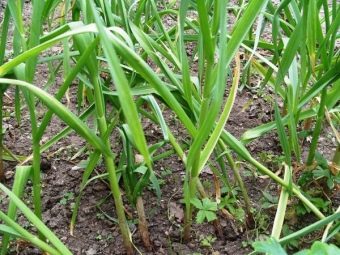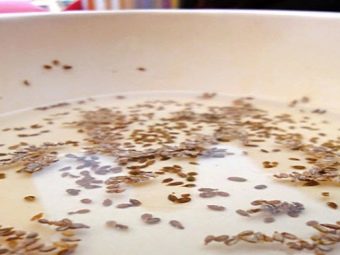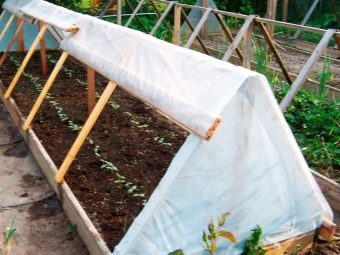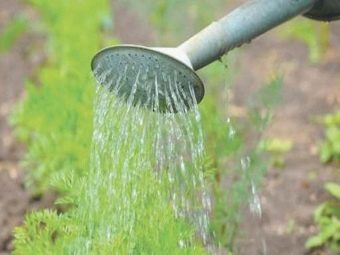After what crops can you plant carrots?
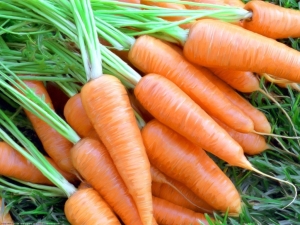
Carrots - one of the most attractive crops in the garden. It has a good taste and good for health.But to plant and grow a decent crop, you must first find out how to do it correctly.
Growing conditions
Carrots are considered relatively resistant to cold weather plants. Its seeds will germinate already at a temperature of +4 to +6 degrees. If the air is heated to +8, germination can be expected between 25 and 35 in the afternoon after sowing. When the temperature rises to 25 degrees, this will require a maximum of 11 days.
Seedlings before the appearance of root hairs consume those nutrients that are included in the seed itself. Lengthening such a period due to very low or too high temperatures adversely affects the plant. Carrots can grow, but it will be weakened and lose its natural defense against various infections.
Vegetable is able to survive short frosts, reaching 4 degrees. It should be remembered that crops before winter or in the first part of spring should be planned with a bypass of cold snaps. It is recommended to plant root crops at a temperature of + 15-20 degrees. But the green part develops better in the temperature range from 20 to 23 degrees.
If it gets hotter by +25, growth slows. On cold ground, especially with poor drainage, a pale-looking carrot of unusual shape is likely to appear. Overheating of the ground against the backdrop of hot summer lowers the saturation of the color. Since swelling of seeds cannot occur quickly, the soil moisture is critical after sowing. The normal development of carrots is ensured only with a steady flow of moderate amounts of moisture, sharp massive irrigation threatens to crack the fruit.
For carrots, areas with loose light loam or sandy loam are best suited. Clay and heavy loam on drying form a strong crust that prevents seeds from germinating. Therefore, the appearance of very rare and inhomogeneously distributed thickets is likely. The recommended acid-base balance is 6 or 7. If the topsoil is weak and the groundwater is close to the surface, high beds are recommended.
Crop rotation rules
After reviewing the conditions necessary for the development of carrots, gardeners can better understand which crops are allowed to sow in the same area. But, besides the properties of the soil, it is necessary to take into account other parameters that affect the compatibility of plants with each other. It is not recommended to sow carrots in the same place where it grew last year. Failure to comply with this rule greatly increases the risk of infection by pathological organisms and the invasion of harmful insects.
The optimal predecessors of carrots in the garden are:
- cereals;
- cucumbers;
- cabbage of various breeds;
- tomatoes;
- leguminous plants.
Also, experts recommend planting carrots after onions, lettuce, potatoes. Cucumbers can be replaced by carrots not immediately, but after 1-2 years. Initially, the earth will be too saturated with organic components that inhibit the development of the root. Gradually, their concentration will return to normal and there will be no such destructive effect.
Carrots after beets usually does not feel very good. The fact is that both types of root crops require similar nutrition and mutually deplete the soil for each other. But gardeners have a powerful tool that allows it to be corrected, it is about fertilizing. If you add compost, then the next year after the beets you can get from the same place an impressive harvest of delicious carrots. For your information: their simultaneous landing on neighboring beds is welcome.
As for compatibility with the planting of garlic, there is not so simple. Onions, being one of the ideal predecessors for carrots, can replace garlic only after 4 years. But if you sow carrots on the former garlic beds immediately, the result will meet all expectations. According to a significant number of farmers, the proximity of these crops will positively affect the quantity and quality of the crop.
Garlic becomes an almost insurmountable obstacle to carrot flies when planted on the perimeter. The maximum distance at which both plants will support each other is 0.65 m.
Very often the question arises about whether it is better to plant vegetables in spring in open ground or a greenhouse after strawberries. The very culture in one place can grow no more than 3 or 4 years in a row, after which the place should be redeveloped. Strawberries very quickly extract all the nitrogen contained in the soil. Therefore, root vegetables, along with legumes, will be the optimal shift for red berries.
The recommended alternation pattern is as follows (by year):
- legumes and green plants;
- garlic or onion;
- tomatoes and sweet peppers;
- cabbage;
- potatoes;
- carrots and red beets;
- return to the strawberry.
Carrots allowed to plant and after squash. Importantly, after them, you can plant onions and garlic, which greatly improves the chances of gardeners for success. It should be noted that if manure is introduced into the ground, the landing of the carrot should be postponed for 2 years. According to some gardeners, although not all shared, it is ideal to grow pumpkins in front of carrots. And in the number of permissible predecessors, many gardeners make and eggplant.
After which landing is not recommended?
You can not plant carrots after:
- dill;
- fennel;
- cumin;
- cilantro;
- parsley;
- parsnips and several other varieties of greens.
If we talk about the "worst" predecessor, it is parsley. It changes the soil in such a way that increases the intensity of reproduction of pests. It is recommended to wait and temporarily find another place. To compensate for the occurrence of infection can be due to the careful loosening of the earth and pouring it with a saturated solution of potassium permanganate. Best of all, if such preparation will be made in the autumn months; It is useful to note that it does not provide a 100% safety guarantee.
Tips
To know, after which to plant carrots is very useful, but it is equally important to figure out what to replace it with. A typical principle is the consistent replacement of the "roots" on the "tops". The taste and nutritional qualities of root crops are achieved, because these plants take a lot from the soil. And this means that the next year after the carrots it is required to plant crops with minimal complaints about the fertility of the land.
But you can not be limited to them, if you choose plants with surface placement of the roots, as well as requiring a lot of organic feeding.
Well manifest solanaceous culture. Ideally, among the different types of potatoes, you should choose sweet yam. Also a good choice would be cabbage, which helps the soil to regain its strength. In addition to them, it is worth considering such cultures as:
- peas;
- beans;
- beans;
- garlic or onion;
- occasionally radishes.
Some gardeners lay perennial berry plantations, especially common and garden strawberries (often referred to as strawberries). Another way to restore the strength of the earth, which gave a harvest of carrots, is the use of sideratov. Rye and oats, mustard and phacelia improve the structure of the soil, suppress many pests and weeds. In order for the carrot ridge itself to give a positive result, you will need to take into account additional recommendations. So, to make the earth more friable, it is advised to introduce a small amount of sand.
Soil acidity leveling is achieved using chalk, wood ash or dolomite flour. Seeds are pre-immersed in an aqueous solution of salt (30 g per 0.25 kg of water), aging - hour. Those seeds that settle to the bottom, washed with warm water and gently dried. Selected seeds are disinfected and treated with growth accelerators. You can embed it in the ground in any convenient way: in the wells, using tape, watering can, in the sand.
The landing time is determined by the terrain features. When planting carrots after onions, one should not forget that he has saturated the earth with potassium and nitrogen.Prevention of carrot fly infection, if for some reason it is impossible to plant around or near garlic - watering the solution prepared from it. Processing is carried out before the end of the carrot season.
If it is decided to sow onions and carrots on one piece of the garden, it is necessary to thoroughly prepare. Since the fall, the chosen place has been dug up and added 5 kg of humus per 1 m2. The distance between the strips should be 0.2–0.25 m. Furrows under carrots are usually made 20-30 mm deep, but if the soil is dense, this indicator will have to be increased to 80-100 mm.
Under the onion part, furrows of 30-40 mm are formed, the onions are gently pressed into the ground with a pitch of 80-100 mm and covered with ashes. Sowing is carried out at a temperature of 5-8 degrees.
Since the carrot does not feel well on overdried earth, it is necessary to help it by introducing special hydrogel granules. It is recommended to mark the rows with stakes in order not to get entangled in them. In early spring, you can put a greenhouse from the film, after 5-8 days to shed rows of water and return the greenhouse back.
Watering is done later on as the soil dries out. Be sure to weed and loosen all the right places.
Planting between radish and lettuce is allowed, it saves space and, due to early ripening of auxiliary crops, obtains an excellent overall yield.
See the following video for a description of the crop rotation pattern.








